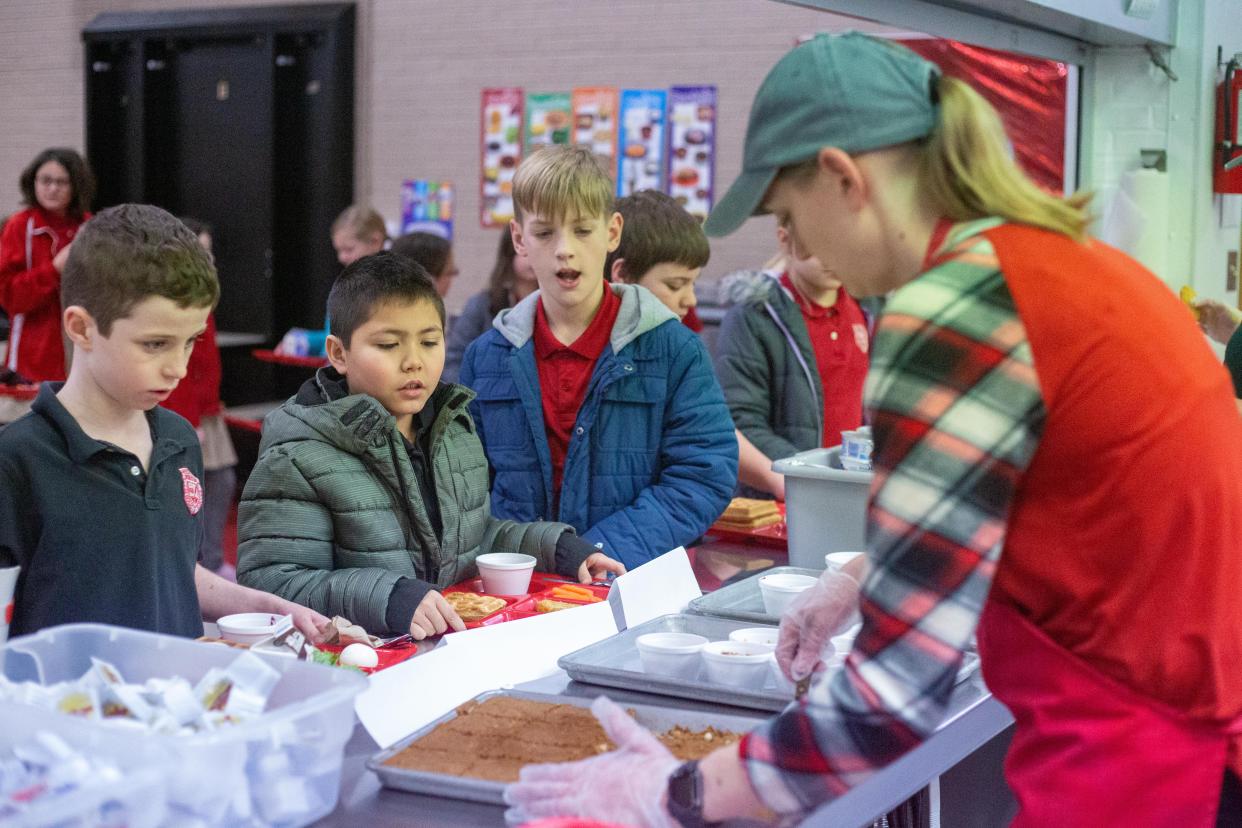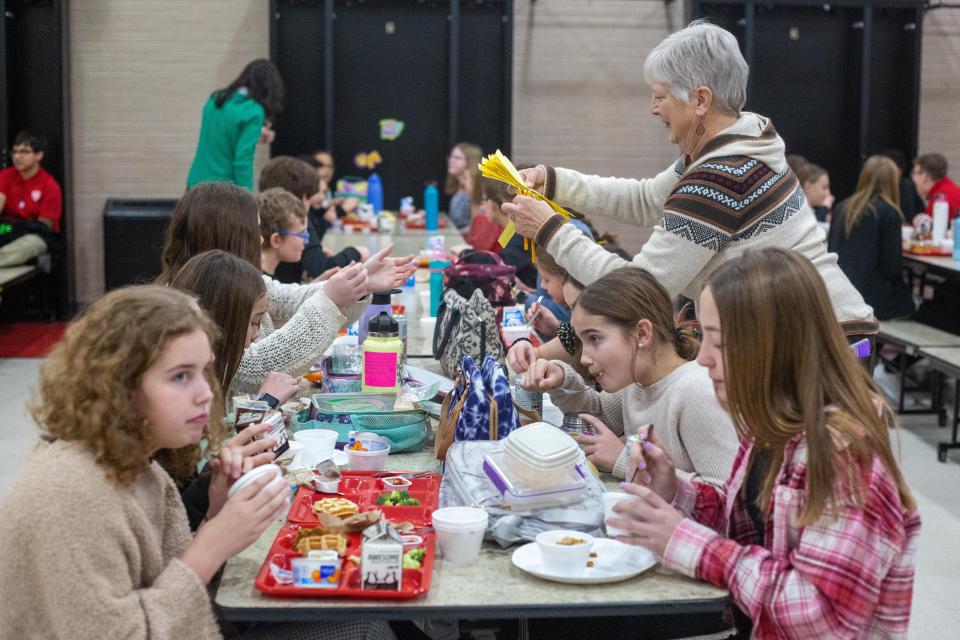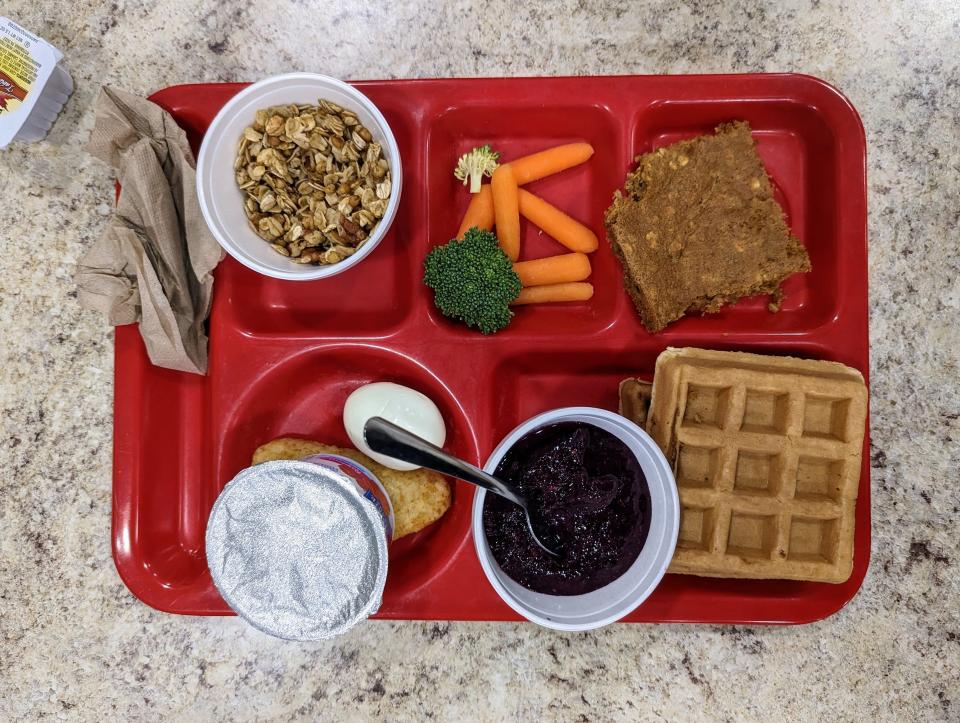Sorghum flour and aronia berries? Student teams use Kansas ingredients in recipe challenge

MANHATTAN — Although they could tell the pumpkin bars were "sandier" than they were used to, the Manhattan Catholic Schools students loved them all the same.
The students were going through the lunch line when they noticed a few items they had never seen before, like the pumpkin bars. Another was a mixture of granola that included big bits of wheat that were unlike anything they'd ever had at school lunch before. Ditto for the strange, dark purple applesauce that seemed to have a special ingredient that gave it a tart, if "earthy," flavor.
More:Kansas high school graduation rates increase. Here's why commissioner says it's not enough
The students were right: These were items only ever served in a handful of other school cafeterias. They would get to test these foods — all designed by Kansas students and all made with locally produced ingredients — before they roll out to schools around the state and country.
As part of a $289,000 federal grant, the Kansas State Department of Education's Child Nutrition and Wellness team organized a multi-year, multi-school district recipe competition that challenged students to pair up with local producers to develop recipes using ingredients from around the state.
"It’s so exciting to see these products that we started developing with high school students across Kansas actually being served in a classroom," said Kyleen Harris, food service director at Manhattan Catholic Schools.
Harris also previously worked at the state education department, and she was the one who originally organized the competition — "I’m just amazed and proud of the products that turned out."
Kansas students designed recipes including locally produced aronia berries, sorghum flour and wheat berries

As part of the recipe challenge last year, schools had to put together teams of students, family and consumer sciences teachers, and local producers to develop food items that met all school nutrition guidelines, were easily scalable, and, most importantly, were tasty among their peers. Each competing school received a $200 sub-grant to purchase and try recipe ingredients.
Of the dozens of recipes the Kansas State Department of Education's Child Nutrition and Wellness team received, five were deemed finalists by a panel of food service directors and viable for testing at scale, said Kelly Chanay, assistant director at KSDE.
They included the following:
• Poppa Chocky Muffin, a chocolate muffin recipe developed by West Elk High School students that uses sorghum flour.
• Pumpkin Breakfast Bar, made with whole grain sorghum flour. Since sorghum flour can feel sandy to some palates, the team of child nutrition directors modified the West Elk High School submission with additional oats and spices to improve taste and texture.
• Kansas Granola, a grain mixture that includes entire, edible wheat kernels. The recipe, developed by Valley Falls High School students, was slightly modified to include roasted soybeans as a local ingredient, since human-grade oats are hard to locally source to scale in Kansas.
• Berry Delicious, an applesauce mixture, also developed by Valley Falls students, that uses tart, blueberry-like aronia berries (also known as chokeberries). Originally created as a thick, earthy smoothie, the recipe was turned into an applesauce to better manage expectations on the recipe's consistency and texture.
• Eggs-Go, hard-boiled eggs with an accompanying dip. This recipe was initially a finalist but later nixed in testing after food service programs found it would be too hard for even large food service operations to peel that many eggs.
A chef helped with all of the recipe adjustments, but the food service directors also had to make changes to make sure each recipe was easily scalable and could be made in batches of at least 100. A recipe designed for six servings won't necessarily multiply easily into that big a number, Chanay said.
"When the math comes out, it’s not always realistic," she said. "We can’t put an eighth of an egg in a recipe."
Other submissions, like a sunchoke soup that used Jerusalem artichokes, were considered but ultimately deemed nonviable because of the large amount of labor it would take to prepare the items from scratch.
Kansas lunchrooms can be classrooms, too

With feedback from the Manhattan Catholic Schools students and prior testing at large, medium and small schools in Shawnee Mission, Hutchinson and Haven, respecively, the child nutrition team will make final tweaks to each of the four remaining recipes.
Once that step is finalized, the team will recognize all of the winning schools and prepare videos talking with each of the local producers about their ingredients and production process.
The team will also bring in a food stylist to prepare the items for photos that will accompany each recipe as it submitted to the Institute of Child Nutrition's Recipe Box, a national collection of easy-to-make, tried-and-true recipes school nutrition programs can use to meet U.S. Department of Agriculture standards.
More:Kansas didn't have a state fruit. These fourth- and fifth-graders set out to fix that.
Although the recipe challenge has taken multiple years to see through, Chanay said the collective effort among all the competing schools and child nutrition staff has been worth it, especially since it has involved students. Throughout the process, they've learned academic and life skills, like multiplying fractions and working in a team.
"It’s a great educational opportunity for the students who participated in these grant activities, and you end up with recipes that have been student-tested and student-approved," Chanay said. "Our food service managers and staff can already know that these recipes are good recipes, while highlighting our local products."
And even for the students who only taste and try the food, the process can be a lesson, too, said Harris, the Manhattan Catholic Schools food service director.
Too often, adults assume that kids will only eat their "favorites."
More:Gov. Laura Kelly adds to growing pressure on Congress to make free school lunch permanent
"(The lunchroom) is my classroom, and I’m always excited to teach kids," she said. "Anytime we can spotlight our food and teach kids about food that was grown near them, it’s a great opportunity for kids. Kids are open to anything, especially when you make it a fun event like this. They’re way more open to trying things than we give them credit for."
Rafael Garcia is an education reporter for the Topeka Capital-Journal. He can be reached at rgarcia@cjonline.com or by phone at 785-289-5325. Follow him on Twitter at @byRafaelGarcia.
This article originally appeared on Topeka Capital-Journal: Kansas school lunch recipe challenge focuses on local ingredients

